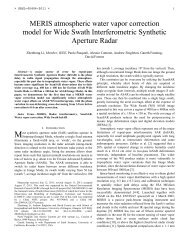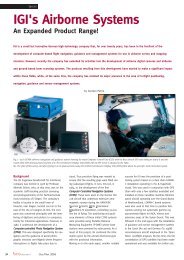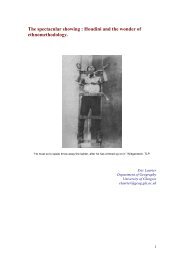Mobile Mapping Systems - University of Glasgow
Mobile Mapping Systems - University of Glasgow
Mobile Mapping Systems - University of Glasgow
You also want an ePaper? Increase the reach of your titles
YUMPU automatically turns print PDFs into web optimized ePapers that Google loves.
second or frame images that are 1,280 x 960<br />
pixels (1.2 Megapixels) in size at a rate <strong>of</strong> 7.5<br />
frames per second. These individual cameras<br />
will <strong>of</strong>ten be deployed in multiple in different<br />
configurations depending on the specific types<br />
<strong>of</strong> features that need to be mapped [Fig. 2].<br />
Usually each <strong>of</strong> the individual cameras that are<br />
mounted on a mobile mapping vehicle will be<br />
enclosed in a special housing that will protect<br />
it from rain and dust. Often the housing will<br />
be equipped with a Sun shroud and also with<br />
a heater/defroster unit, the latter helping to<br />
keep the camera operational in cold weather<br />
conditions.<br />
However the use <strong>of</strong> fully integrated multiple multiple<br />
camera camera units is now very common in mobile<br />
mapping vehicles. As will be seen later, the<br />
Ladybug series <strong>of</strong> multiple cameras built by<br />
Point Grey Research, based in Richmond, B.C.,<br />
Canada, have been adopted widely for use in<br />
mobile mapping systems [Fig. 3]. The company’s<br />
Ladybug2 multiple camera unit has six<br />
Sony CCD digital video cameras. Five <strong>of</strong> these<br />
cameras are arranged concentrically in a horizontal<br />
ring pointing outwards to produce a<br />
360 degree panoramic image within the horizontal<br />
plane, with the sixth camera pointing<br />
vertically upwards. These cameras have a<br />
FireWire-B (IEEE1394-B) 800 Megabit interface<br />
and cabling to provide camera control and<br />
power and to implement video data transmission<br />
at the rate <strong>of</strong> 15 uncompressed frame images per second, each<br />
image being 1,024 x 768 pixels (= 0.8 Megapixels) in size. The Ladybug3<br />
unit also has a set <strong>of</strong> six Sony CCD cameras arranged in a similar circular<br />
five-camera configuration (plus a single vertical camera) but with<br />
still larger formats (1,600 x 1,200 pixels). Thus it can generate six 2-<br />
Megapixel images that can be streamed as uncompressed images at<br />
the rate <strong>of</strong> 7 frames per second or as compressed JPEG images at a 15<br />
frames per second rate. Each Ladybug multiple camera unit can be supplied<br />
attached to a mast that can be mounted on a ro<strong>of</strong> rack that has<br />
been placed on top <strong>of</strong> the mapping vehicle to provide a clear view <strong>of</strong><br />
the surrounding objects.<br />
Another integrated multiple camera unit that has received a great deal<br />
<strong>of</strong> publicity and attention from the media because <strong>of</strong> its distinctive<br />
shape and appearance is the Dodeca 2360 [Fig. 4] The name is derived<br />
Fig. 3 – The cylindrical-shaped Ladybug2 (left) and the pentagonal-shaped<br />
Ladybug3 (right) integrated multiple camera systems, which are operated with<br />
FireWire-B (IEEE1394-B) interfaces and cabling. (Source: Point Grey Research)<br />
Latest News? Visit www.geoinformatics.com<br />
Fig. 2 – These diagrams show the different<br />
configurations <strong>of</strong> digital video cameras that have been<br />
utilized on the mobile mapping vehicles that are being<br />
operated by Tele Atlas. Diagrams (a), (b) and (c) show<br />
alternative arrangements using four cameras, while<br />
(d) shows a six-camera arrangement.<br />
(Source: Tele Atlas; Re-drawn by Mike Shand)<br />
33<br />
Article<br />
Fig. 4 – The Dodeca 2360<br />
integrated multiple camera<br />
system produced by<br />
Immersive Media comprises<br />
eleven individual video<br />
camera firing simultaneously.<br />
(Source: Immersive Media)<br />
from the geodesic geometry <strong>of</strong> the dodecahedron,<br />
which is a 12-faced solid figure (with<br />
each face having a pentagonal shape) that<br />
approximates to that <strong>of</strong> a sphere. The overall<br />
Dodeca 2360 unit utilizes eleven <strong>of</strong> the 12<br />
faces, in each <strong>of</strong> which a small-format camera<br />
is mounted, while the twelfth face forms the<br />
base on which the camera is mounted. Usually<br />
the camera will be attached to a mast that<br />
can be mounted on the ro<strong>of</strong> <strong>of</strong> the mapping<br />
vehicle. The Dodeca camera was devised by<br />
another Canadian company, Immersive Media<br />
Corporation Inc. (IMC), based in Calgary,<br />
Alberta. Originally the camera was manufactured<br />
by Freestone <strong>Systems</strong> in Dallas, Texas.<br />
In 2007, IMC acquired the Freestone company,<br />
which was then renamed IMC Sensors Inc.<br />
Each <strong>of</strong> the Dodeca cameras generates a<br />
frame image that is 640 x 480 pixels in size,<br />
the overall size <strong>of</strong> the resulting merged and<br />
stitched “spherical” image formed from the<br />
multiple individual images is 2,400 x 1.200<br />
pixels.<br />
The Google company made use <strong>of</strong> this type <strong>of</strong> Dodeca frame imagery<br />
when it introduced its “Street View” service in 2007. However Google<br />
then switched to using its own multiple camera units thereafter. The<br />
Google integrated multiple camera system comprises nine individual<br />
CCD cameras, eight <strong>of</strong> which are arranged, spaced equally, in a concentric<br />
ring pointing outwards, with the ninth camera pointing vertically<br />
upwards [Fig. 5]. The individual cameras are reported to have been supplied<br />
by an American company, Elphel Inc., which is based in Salt Lake<br />
City, Utah. The Elphel 313 and 333 models are digital network cameras<br />
using CMOS area arrays that are delivered with s<strong>of</strong>tware source code<br />
supplied under Open Source terms (like those applying to the Linux<br />
operating system or the Firefox browser). The Elphel 313 camera generates<br />
images with a frame size <strong>of</strong> 1,280 x 1,024 pixels at the rate <strong>of</strong> 15<br />
frames per second or larger images, e.g. with 1,600 x 1,200 pixels, at a<br />
lower rate. The later Elphel 333 camera can generate compressed JPEG<br />
images that are 2,048 x 1,536 pixels<br />
(3.2 Megapixels) in size at the<br />
rate <strong>of</strong> 12 frames per second.<br />
Fig. 5 – The integrated<br />
nine-camera system that is mounted<br />
and operated on the Google company’s<br />
cars that acquire imagery for its<br />
Street View service. (Source: Google)<br />
January/February 2010
















